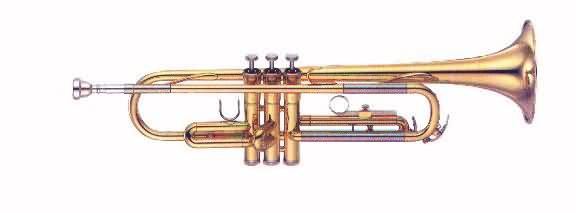Trumpets, Cornets, Flugelhorns
Bugles were the forerunners of the trumpet, cornet, and flugelhorn. These instruments had no valves and if players needed to play in a different key, they simply used a different instrument pitched in that key. This was difficult. The invention of valves made it possible to use a single instrument to play in a variety of keys.
Trumpets, cornets, and flugelhorns are very similar. They are all made of brass, have three piston valves that move up and down, and they all have a similar range. They can play the highest notes of all brass instruments. When the second valve is pushed down it makes the air travel a short additional distance through a small tube on the side of the instrument. This produces a note that is a half step (minor 2nd) lower than the open horn. The first valve makes the air travel further through a little longer tube and results in a whole step (major 2nd) below the original note. The third valve adds even more distance and lowers the pitch even more. Combinations of valves can also be used. Examples might be first and second, second and third, and first and third.
There are two types of tubing found on brass instruments. One is cylindrical. Think of cylindrical as a drinking straw. This means that the tube is the same diameter. The other type of tubing is conical. This means that the tube gets larger and larger in diameter. Think of conical as a cone.
It is the difference in these two types of tubing that causes the differences seen and heard between the cornet, trumpet and flugelhorn. The trumpet is the most cylindrical and the flugelhorn is the most conical with the cornet falling somewhere in the middle.
Trumpets, cornets, and flugelhorns are used in many musical ensembles, most frequently playing classical or jazz music.
Study the image provided and listen to the sound sample of the trumpet to gain an understanding of this instrument.
![]() Listen to a sample of the trumpet:
Listen to a sample of the trumpet:
